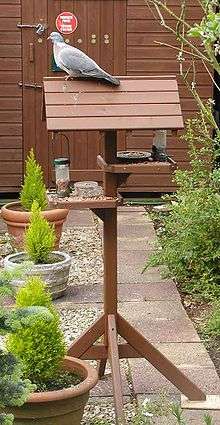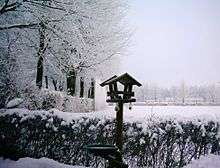Bird feeding
Bird feeding is the activity of feeding wild birds, often by means of a bird feeder. With a recorded history dating to the 6th century, the feeding of wild birds has been encouraged and celebrated in the United Kingdom and United States, with it being the United States' second most popular hobby having National Bird-Feeding Month congressionally decreed in 1994. Various types of food are provided by various methods; certain combinations of food and method of feeding are known to attract certain bird species.

The feeding of wild birds has been shown to have possible negative as well as positive effects; while a study in Sheffield, England found that the abundance of garden birds increased with levels of bird feeding, multiple reports suggest that bird feeding may have various negative ecological effects and may be detrimental to the birds being fed, including increased risk of predatory action and malnutrition. It has been estimated that American adults spend approximately US$3.8 billion a year on food, feeders and related accessories.
History
The British naturalist James Fisher wrote that the first person recorded as feeding wild birds was the 6th-century monk Saint Serf of Fife who tamed a pigeon by feeding it. During the harsh winter of 1890–1891 in the United Kingdom national newspapers asked people to put out food for birds. In 1910 in the United Kingdom, Punch magazine declared that feeding birds was a "national pastime."[1] Today in the United Kingdom, most people feed year-round, and enough food is provided to support the calorie requirements of the 10 most common garden bird species.[2] Bird feeding has grown into the United States' second most popular hobby behind gardening.[3] To celebrate the bird feeding hobby, February was named National Bird-Feeding Month by congressional decree in 1994.[4]
Activity
Bird feeding is typically thought of as an activity of bird enthusiasts. People who feed wild birds often attempt to attract birds to suburban and domestic locations. This requires setting up a feeding station and supplying bird food. The food might include seeds, peanuts, bought food mixes, fat, kitchen scraps and suet. Additionally, a bird bath and grit (sand), that birds store in their crops to help grind food as an aid to digestion, can be provided.
Feeding bread to waterfowl at parks, lakes and rivers is also a popular activity.
Types

Certain foods tend to attract certain birds.[5] Finches and siskin will be attracted by Niger,[6] and jays love maize. Hummingbirds, sunbirds and other nectivorous birds love nectar. Mixed seed and black oil sunflower seed is favoured by many seed-eating species. In Australia, meat, especially raw beef mince (or ground beef), is commonly fed to wild, carnivorous birds such as Australian magpies and kookaburras. [7] Birds such as white-eyes, barbets, and some thrushes will take fresh and cut fruit. Different feeders can be purchased specialized for different species. It is not only small birds that are attracted by bird feeding. In some urban areas of the UK, red kites are fed chicken and table scraps in gardens.[8][9]
Garden birds can be fed using peanuts, seed, coconut (but never desiccated coconut) or fat (but not oils that are liquid at room temperature) using a variety of feeders.[10]
After a station is established, it can take some weeks for birds to discover and start using it. This is particularly true if the feeding station is the first one in an area or (in cold-winter areas) if the station is being established in spring when natural sources of food are plentiful. Food, particularly unshelled foods, such as thistle seed and suet, left uneaten for too long may spoil. Birds also require a source of drinking water and a bird bath can attract as many birds as a feeding station.
In North America, suet can be used to attract a variety of birds that may not reliably visit a birdfeeder containing seeds. In Texas, all common species of woodpeckers will use a suet feeder year round. In winter, yellow-rumped and orange-crowned warblers, golden-crowned kinglets and northern flickers could visit. In spring, northern oriole and other warblers may also visit.
Impact


A study conducted in Sheffield, England, found that the abundance of garden birds increased with levels of bird feeding. This effect was only apparent in those species that regularly take supplementary food, raising the possibility that bird feeding was having a direct effect on bird abundance. In contrast, the density of feeding stations had no effect on the number of different bird species present in a neighbourhood.[11]
The use of bird feeders has been claimed to cause environmental problems; some of these were highlighted in a front-page article in The Wall Street Journal.[12]
Prior to the publication of The Wall Street Journal article, Canadian ornithologist Jason Rogers also wrote about the environmental problems associated with the use of bird feeders in the journal Alberta Naturalist.[13] In this article, Rogers explains how the practice of feeding wild birds is inherently fraught with negative impacts and risks such as fostering dependency, altering natural distribution, density and migration patterns, interfering with ecological processes, causing malnutrition, facilitating the spread of disease and increasing the risk of death from cats, pesticides, hitting windows and other causes. In the UK, introduced eastern gray squirrels can consume significant volumes of food intended for birds.[14] An experimental study providing supplementary food during the breeding season found that predation levels by corvids and eastern gray squirrels were higher when nests were located in close proximity to filled feeders.[15]
In a paper in the journal Oecologia, it was reported that feeding of blue tits and great tits with peanut cake over a long time period significantly reduced brood size. This was driven by smaller clutch sizes in both species and lower hatching success rates for blue tits.[16] Studies by the University of Freiburg and Environment Canada found that blackcaps migrating to Great Britain from Germany had become adapted to eating food supplied by humans. In contrast blackcaps migrating to Spain had bills adapted to feeding on fruit such as olives.[17]
Providing supplementary food at feeding stations may also change interactions with other species. Aphids[18] and carabid beetles[19] are more likely to be predated by birds near bird feeders.
Economy
Large sums of money are spent by ardent bird feeders, who indulge their wild birds with a variety of bird foods and bird feeders. Over 55 million Americans over the age of 16 feed wild birds and spend more than $3 billion a year on bird food, and $800 million a year on bird feeders, bird baths, bird houses and other bird feeding accessories.[20] The activity has spawned an industry that sells supplies and equipment for the bird feeding hobby.
In some cities or parts of cities (e.g. Trafalgar Square in London[21]) feeding pigeons is forbidden, either because they compete with vulnerable native species, or because they abound and cause pollution and/or noise.
See also
- Bird food plants – certain trees, shrubs and herbaceous plants bearing fruits which afford food for birds
- Do not feed the animals – a policy forbidding the artificial feeding of wildlife, commonly signposted in places where people come into contact with wildlife
- National Bird-Feeding Society (NBFS) – an organization in the United States whose mission is to make the hobby of bird feeding better, both for people who feed wild birds and for the birds themselves
- Nectar source – a flowering plant that produces nectar, sometimes attracting birds such as hummingbirds
- Suet cake – or "fat balls" are nutritional supplements for wild birds, commonly consisting of sunflower seeds and wheat or oat flakes mixed with suet
References
- Moss, Stephen 2004 A bird in the bush. Aurum Press. p 102-103
- Orros, Melanie E.; Fellowes, Mark D. E. (2015-06-01). "Wild Bird Feeding in an Urban Area: Intensity, Economics and Numbers of Individuals Supported". Acta Ornithologica. 50 (1): 43–58. doi:10.3161/00016454AO2015.50.1.006. ISSN 0001-6454.
- Richardson, Scott. "Feeding Time." Pantagraph [Bloomington, IL] 31 January 2010. Print.
- U.S. House. Representative John Porter of Illinois speaking on National Wild Bird Feeding Month. 103rd Cong. Congressional Record (23 February 1994). Volume 140.
- ""Which Bird Seeds are Best?" from National Wildlife Magazine 1/31/2010". Nwf.org. 2011-10-26. Retrieved 2011-11-15.
- "Breathing Places - Nature activities". BBC. Retrieved 2011-11-15.
- Reynolds, S. James; Galbraith, Josie A; Smith, Jennifer A; Jones, Darryl N (2017). "Garden Bird Feeding: Insights and Prospects from a North-South Comparison of This Global Urban Phenomenon". Frontiers in Ecology and Evolution. 5. doi:10.3389/fevo.2017.00024.
- Orros, Melanie E.; Fellowes, Mark D. E. (2014-04-03). "Supplementary feeding of the reintroduced Red Kite Milvus milvus in UK gardens" (PDF). Bird Study. 61 (2): 260–263. doi:10.1080/00063657.2014.885491. ISSN 0006-3657.
- Orros, Melanie E.; Fellowes, Mark D. E. (2015-04-01). "Widespread supplementary feeding in domestic gardens explains the return of reintroduced Red Kites Milvus milvus to an urban area". Ibis. 157 (2): 230–238. doi:10.1111/ibi.12237. ISSN 1474-919X. PMC 4409027. PMID 25937644.
- "BBC webpage on feeding birds". bbc.co.uk. Retrieved 2011-11-15.
- Fuller, R.A., Warren, P.H., Armsworth, P.R., Barbosa, O. & Gaston, K.J. 2008. Garden bird feeding predicts the structure of urban avian assemblages. Diversity & Distributions 14, 131–137. doi:10.1111/j.1472-4642.2007.00439.x
- Sterba, James B. "Crying Fowl: Feeding Wild Birds May Harm Them and Environment", Wall Street Journal, December 27, 2002.
- Rogers, J. 2002. Birdfeeding: Another viewpoint. Alberta Naturalist 31: 1-11.
- Hanmer, Hugh J.; Thomas, Rebecca L.; Fellowes, Mark D. E. (2018). "Introduced Grey Squirrels subvert supplementary feeding of suburban wild birds" (PDF). Landscape and Urban Planning. 177: 10–18. doi:10.1016/j.landurbplan.2018.04.004.
- Hanmer, H. J.; Thomas, R. L.; Fellowes, M. D. E. (2017). "Provision of supplementary food for wild birds may increase the risk of local nest predation" (PDF). Ibis. 159 (1): 158–167. doi:10.1111/ibi.12432.
- Harrison, Timothy J. E.; Smith, Jennifer A.; Martin, Graham R.; Chamberlain, Dan E.; Bearhop, Stuart; Robb, Gillian N.; Reynolds, S. James (2010). "Does food supplementation really enhance productivity of breeding birds?". Oecologia. 164 (2): 311–320. Bibcode:2010Oecol.164..311H. doi:10.1007/s00442-010-1645-x. PMID 20473622.
- "Feeding birds can affect evolution: study - Technology & Science - CBC News". Cbc.ca. 2009-12-04. Retrieved 2011-11-15.
- Orros, Melanie E.; Fellowes, Mark D.E. (2012). "Supplementary feeding of wild birds indirectly affects the local abundance of arthropod prey". Basic and Applied Ecology. 13 (3): 286–293. doi:10.1016/j.baae.2012.03.001.
- Orros, Melanie E.; Thomas, Rebecca L.; Holloway, Graham J.; Fellowes, Mark D. E. (2015-06-01). "Supplementary feeding of wild birds indirectly affects ground beetle populations in suburban gardens". Urban Ecosystems. 18 (2): 465–475. doi:10.1007/s11252-014-0404-x. ISSN 1083-8155. PMC 4498636. PMID 26190913.
- "Survey of Fishing, Hunting, and Wildlife Associated Recreation–National Overview 2007." U.S. Fish and Wildlife Service. 2006.
- "Trafalgar's pigeon ban extended". BBC News. 10 September 2007. Retrieved 14 August 2017.
External links
| Wikimedia Commons has media related to Bird feeding. |